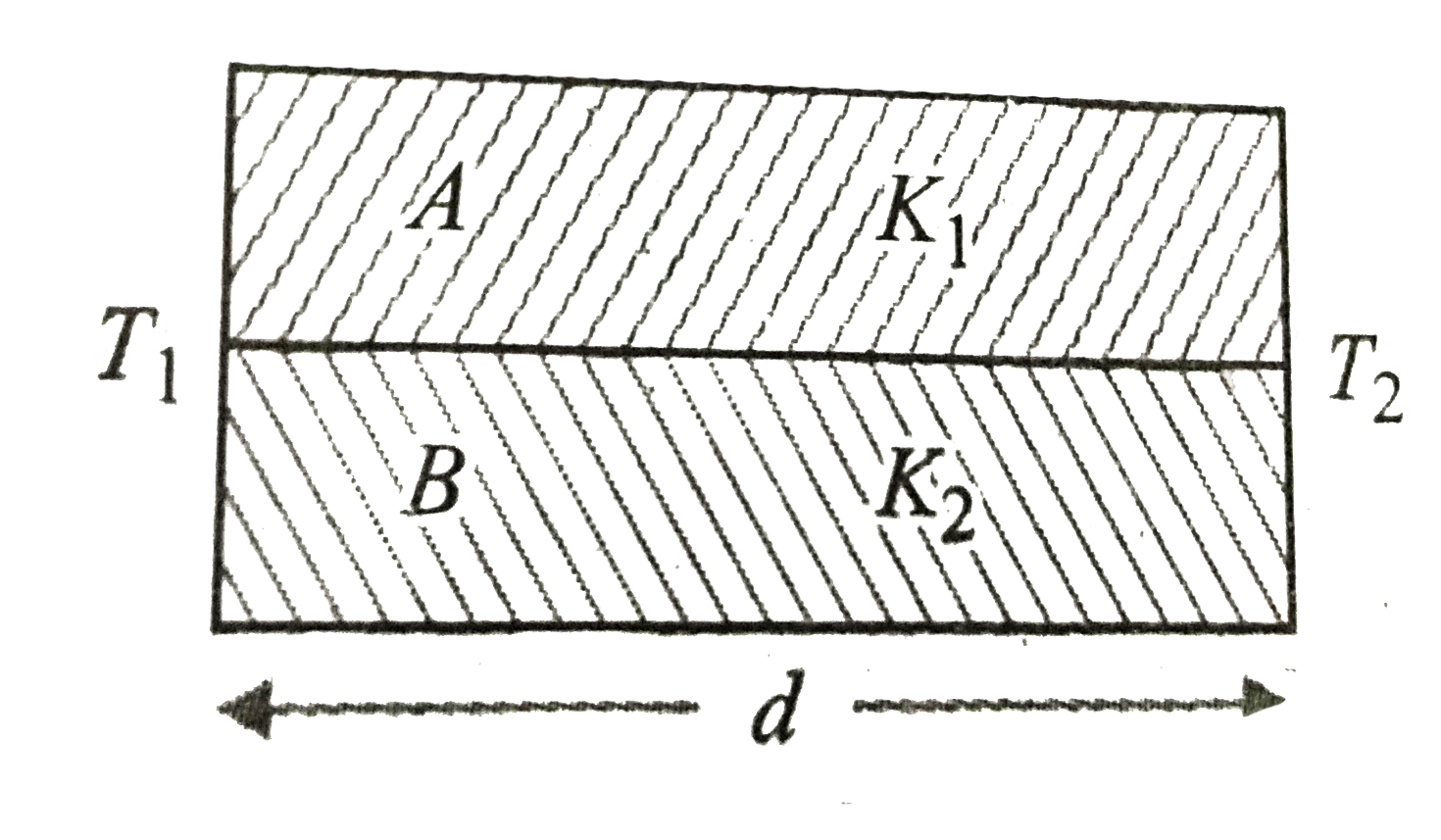A slab consists of two parallel layers of two different materials of same thickness having thermal conductivities . The equivalent conductivity of the combination is
The correct Answer is:B
To find the equivalent thermal conductivity of a slab consisting of two parallel layers of different materials with the same thickness, we can follow these steps:
1. Understand the Configuration:
We have two slabs made of different materials with thermal conductivities K1 and K2. Both slabs have the same thickness L and are arranged in parallel.
2. Identify the Area:
Let the cross-sectional area of each slab be A. Since they are in parallel, the total area for heat conduction will be 2A (the area of both slabs combined).
3. Calculate the Thermal Resistance:
The thermal resistance R for a slab is given by the formula:
R=LKA
Therefore, for each slab:
- For the first slab (material with conductivity K1):
R1=LK1A
- For the second slab (material with conductivity K2):
R2=LK2A
4. Use the Parallel Resistance Formula:
When resistances are in parallel, the equivalent resistance Req is given by:
1Req=1R1+1R2
Substituting the values of R1 and R2:
1Req=K1AL+K2AL
5. Combine the Terms:
Factor out AL:
1Req=AL(K1+K2)
6. Find the Equivalent Conductivity:
The equivalent thermal resistance can also be expressed in terms of the equivalent conductivity Keq:
Req=LKeq⋅2A
Setting the two expressions for Req equal:
LKeq⋅2A=1AL(K1+K2)
7. Solve for Keq:
Cross-multiplying gives:
Keq⋅2A=L2A(K1+K2)
Rearranging gives:
Keq=K1+K22
Final Answer:
The equivalent thermal conductivity Keq of the combination is:
Keq=K1+K22
We have two slabs made of different materials with thermal conductivities K1 and K2. Both slabs have the same thickness L and are arranged in parallel.
Let the cross-sectional area of each slab be A. Since they are in parallel, the total area for heat conduction will be 2A (the area of both slabs combined).
The thermal resistance R for a slab is given by the formula:
R=LKA
Therefore, for each slab:
- For the first slab (material with conductivity K1):
R1=LK1A
- For the second slab (material with conductivity K2):
R2=LK2A
When resistances are in parallel, the equivalent resistance Req is given by:
1Req=1R1+1R2
Substituting the values of R1 and R2:
1Req=K1AL+K2AL
Factor out AL:
1Req=AL(K1+K2)
The equivalent thermal resistance can also be expressed in terms of the equivalent conductivity Keq:
Req=LKeq⋅2A
Setting the two expressions for Req equal:
LKeq⋅2A=1AL(K1+K2)
Cross-multiplying gives:
Keq⋅2A=L2A(K1+K2)
Rearranging gives:
Keq=K1+K22
The equivalent thermal conductivity Keq of the combination is:
Keq=K1+K22
Topper's Solved these Questions
- BOOK - AAKASH INSTITUTECHAPTER - THERMAL PROPERTIES OF MATTEREXERCISE - Assignment (Section-B) Objective Type questions (one option is correct)15videos
THERMAL PROPERTIES OF MATTER
- BOOK - AAKASH INSTITUTECHAPTER - THERMAL PROPERTIES OF MATTEREXERCISE - Assignment (Section-C) Objective Type questions (More than one option are correct)13videos
THERMAL PROPERTIES OF MATTER
- BOOK - AAKASH INSTITUTECHAPTER - THERMAL PROPERTIES OF MATTEREXERCISE - Try Youself16videos
THERMAL PROPERTIES OF MATTER
- BOOK - AAKASH INSTITUTECHAPTER - TEST 9EXERCISE - EXAMPLE61videos
TEST 9
- BOOK - AAKASH INSTITUTECHAPTER - THERMODYNAMICSEXERCISE - ASSIGNMENT (SECTION -D) (Assertion - Reason Type Questions)10videos
THERMODYNAMICS
Similar Questions
A slab consists of two parallel layers of different materials 4cm and 2cm thick and of thermal conductivities 54cals−1m−1K−1 and 36cals−1m−1K−1 respectively. If the faces of the slab are at 100∘C and 0∘C calculate the temperature of the surface dividing the two materials.
View SolutionTwo rods of the same length and diameter having thermal conductivities K1 and K2 are joined in parallel. The equivalent thermal conductivity of combination is
View Solution
Knowledge Check
- Question 1 - Select One
A slab consists of two layers of different materials of the same thickness and having thermal conductivities K1 and K2. The equivalent thermal conductivity of the slab is
AK1+K2BK1K2K1+K2C√K1K2D2K1K2K1+K2 - Question 2 - Select One
Two rods of the same length and diameter, having thermal conductivities K1 and K2, are joined in parallel. The equivalent thermal conductivity to the combinationk is
AK1K2K1+K2BK1K2CK1+K22D√K1K2 - Question 3 - Select One
Two rods of the same length and diameter having thermal conductivities K1 and K2 are joined in parallel. The equivalent thermal conductivity of combination is
AK1K2K1+K2B(K1+K2)CK1+K22D√K1K2
Consider a compound slab consisting of two different material having equal thickness and thermal conductivities K and 2K respectively. The equivalent thermal conductivity of the slab is
View SolutionConsider a compound slab consisting of two different material having equal thickness and thermal conductivities K and 2K respectively. The equivalent thermal conductivity of the slab is
View SolutionTwo rods A and B of different materials are welded together as shown in figure. Their thermal conductivities are K1 and K2. The thermal conductivity of the composite rod will be
 View Solution
View SolutionTwo rods A and B of different materials are welded together as shown in figure. Their thermal conductivities are K1 and K2. The thermal conductivity of the composite rod will be
 View Solution
View SolutionA slab consists of two parallel layers of copper and brass of the time thickness and having thermal conductivities in the ratio 1:4. If the free face of brass is at 35∘C and that of copper at 1:√2.5, the temperature of interface is
View Solution

